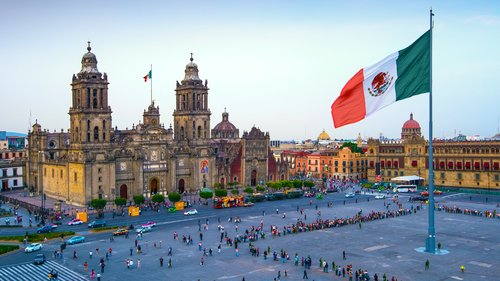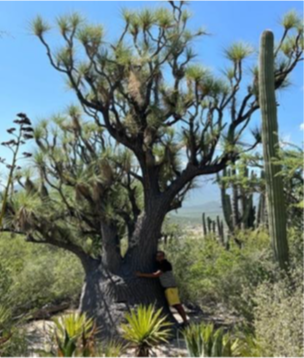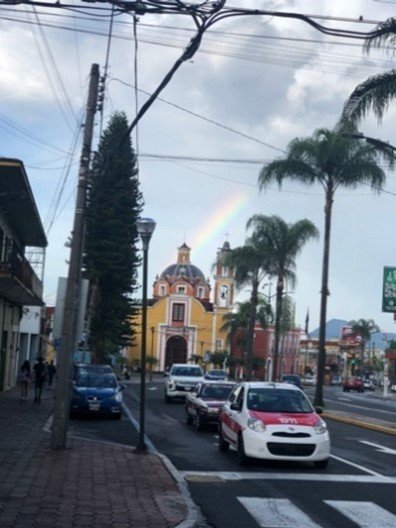The Resurgence Of The Aztecs
Monday, 25 September 2023By Amit Sharma

Mexico and I have no relationship, it was actually Covid that first brought us together. As countries created barriers between each other and weary travelers become versed in the various tests, certificates and nasal intrusions required to get to their destination, Mexico embraced us with an open-door policy. After returning from my first ever visit in the summer of 22, I noticed a number of UK and International companies either expanding or acquiring businesses in Mexico. Determined to understand the rationale for this trend, I ventured again this summer on a several thousand-mile road trip, to get to know the country better, armed with schoolboy Spanish to understand the people and of course the trend for more investment.
It’s The Economy Stupid
When Bill Clinton coined this expression, he probably never thought it might refer to their southern neighbour, but from a European perspective imagine a country that is pretty much energy sufficient (with large reserves of oil), has a conservative level of sovereign debt (roughly half of the UK), falling inflation, stable interest rates, low levels of unemployment, a willing labour force and a democratic government. Add to this a largely mixed economy with manufacturing, tourism, agriculture (pictured below a pineapple farm in Campeche province) and did we mention year on year GDP growth of 4% for the last couple of years. The game changer was obviously the NAFTA Agreement of 1994, which allowed free trade between Canada/USA and Mexico, but in addition to this, Mexico has over 50 free trade deals with countries around the world and after China can reasonably be called the factory for the world.
The Mexican Wave

Following the 1986 Football World Cup, it was not only the ‘wave’ that was exported across stadiums all over the world, but there was also a massive migration of largely Mexican and people from other Latin American countries north to the US. The diaspora had two material impacts, the first is that it provides Mexico with a massive level of remittances from the US, which has grown annually and is believed to be around $60bn a year, providing a strong stimulus to local economies and thereby consumption. Secondly and perhaps more importantly and to paraphrase the Economist (24 June ) “If America’s Latinos were their own country, they would have had the third fastest -growing economy after China and India during the past decade1” (more details in the Mckinsey report, link below)[1].

A great example of this growing consumer strength can be taken from the Puerto Rican singer ‘Bad Bunny’ (pictured) who you may not have heard of, but he has been Spotify’s most streamed artist in 2020, 2021 and 2022. Whilst concert goers in London have been treated to a double bill of Beyonce and Taylor Swift bringing nostalgia to our capital, it’s the Latino wave that is currently generating the most downloads, with new songs and the birth of Reggeaton. Similarly, the best-selling beer in the US is no longer Budweiser, but rather the Mexican brand ‘Modelo Especial’. When the brand first moved into the US, it targeted a few cities with big Hispanic communities, such as Los Angeles and Chicago and then expanded further afield. The success is down to the growing economic strength and numbers of Latinos that are keen to embrace brands and products from their homeland, providing Mexico with a much bigger and commercially stronger market than it had before.
The Country
Like China and India, Mexico is a continuous civilization that has prospered for many centuries before the Europeans deemed them to be the ‘New World’ and a visit to the Mayan and Aztec ruins dotted around the country provide evidence of their great history. Similarly, their cuisine offers much more than the Taco and Burrito stands that occupy many US cities, in fact attending a Mole sauce tasting menu in Oaxaca, one comes to understand how complex and sophisticated their cooking is, similar to provinces such as Szechuan in China and Kerela in India. The photo is taken near the town of Tehucan, which features the elephant foot cactus, which is believed locally to be over 1000 years old.

Since independence from Spain in 1821, Mexico has had a fairly turbulent history, but culturally it feels much more homogenous than the US and parts of Europe, where polarization between races and political ideologies has separated people. The Catholic church is a mainstay in towns and cities across the country and even some of the smallest towns feature some of the most amazing places for worship, like the church featured below. The family unit remains strong and its very common to see both parents and children take an evening stroll around the many plazas and parks that adorn most Mexican towns.
The Security

Earlier in the year, when I visited Japan and asked people across the country what concerned them most, the answer was consistently China[2]. The country has worked itself into a hysteria about a potential attack on Taiwan, and on Sunday mornings it was possible to see groups around Yoyogi park in Tokyo, hand out leaflets, with grim expressions. As expected, the situation in Mexico is similar, but in place of geopolitical risk, the biggest concern of the people I spoke was around the insecurity and corruption. The drug industry in Mexico continues to grow from strength to strength and with it comes violence, extortion and essentially a state within a state, controlled by gangsters. The officer I spoke with (photo below) in Veracruz was on patrol and his face and thereby identity was covered, so no reprisals could take place against his family and friends.
Almost every 10th car on Mexican roads belongs to some form of state authority, whether the local or state police and of course the military, which openly drive with machine guns on the ready. Under the current Mexican leader Amlo, his catchphrase has been ‘Abrazos no balazos’ which translated means hugs not bullets. When I asked people across the country why and how this problem was occurring it really fell under three pillars
- Growing demand from north of the border,
- Supply of products from 3rd party countries previously Columbia, but increasingly China and;
- Poverty and social inequality, with a get rich quick mentality amongst the young. Unless one of these three pillars are to fall away, this is a problem that Mexico will need to live with and manage as best it can.

In Bacalar, a southern town on the Belize border I was wandering around on a Sunday afternoon in the main plaza on the hunt for some Churros, when a large group of people solemnly descended on the plaza with flags and held a period of silence next to the old fort, each holding photographs of men, women and children. I did not understand at first, but these were missing people. As a result of the insecurity from the gang violence, thousands of people disappear in towns and cities across Mexico and there are limited resources from the police to help find them.
Unusually what you do find in parts of Mexico are some of the strange impacts of the narcotics industry. Whilst in London, oligarchs from exotic countries like to covert their ill-gotten gains into mansions in Mayfair and Belgravia, in Latin America there seems to be a fashion for exotic animals, whether hippos in Columbia or as you can see in the photo below, the most amazing zoo in the small town of Orizaba. The river zoo has five Bengal and one Siberian Tiger, more than London Zoo and no entry fee. Perhaps its legitimate, perhaps not, but just as I would not knock on the door of a Mayfair mansion, I felt it was probably inappropriate to ask and just enjoy the view.
The Hidden Risk
From the moment you land in Mexico its very apparent there is a security issue, especially with the number of military police moving around the streets. However, surprisingly it’s not the drug cartels that are responsible for the most deaths in Mexico, but rather its diabetes and a lot of the blame for this can be apportioned to the Atlanta based company, Coca Cola.

As the largest consumer of soft fizzy drinks in the world, Mexicans consume over 163 litres per person per year, and Coca Cola products represents more than 70% of the consumption. It was reported recently that the top three sources of daily calories were all high calorie drinks.
Travelling through towns and villages, particularly in the south, where bottled water is not always available, but cola is and that too the original flavour and not diet versions. This huge level of consumption which has grown over the last 20 years has led to a massive growth in obesity. For example, Mexico’s National Survey of Health reported that between 1999 and 2006, the average waistline for Mexican women of childbearing age grew by nearly 11cm and during the same time, child obesity among children aged 5-11 rose by 40%[3]. The situation since then has got much worse and around 145,000 people die each year due to Diabetes, although the actual number is likely to be much higher, as detection, treatment and reporting is not on par with European countries.
Success of a country cannot only be measured by GDP, but also the longevity and health of its population. As Mexico gets richer, it’s also getting fatter and with-it lifestyle diseases will hamper its future growth and development. Imposing more taxes and restrictions on the soft drink industry is an uphill task, given their powerful lobby and this might be yet another case of more hugs, as the country as a whole becomes cuddlier.
Investment Opportunity
After I had seen the good and bad, I wanted to get a sense of who was investing in Mexico and why and to do this, it was useful to get the view of old Mexico hands and the more recent investors. Mark Hoad, a good friend and CFO at TT Electronics has regularly visited the company’s factories in Mexico, where they have had a presence for more than 30 years and added ‘we are so pleased with our presence and are looking to grow, especially on the back of reshoring and expect to increase headcount.’
Similarly, RS Group plc last year acquired Risoul the family-owned Mexican distributor in a deal worth $275m, which gives it access to the fast growing Mexican and Latin American markets and Sally Tilley (Group Treasurer) shared that ‘the acquisition is a huge deal for RS Group and in particular for our Americas business and builds great momentum and enormous growth opportunities.’
Looking Forward
Prior to my trip, it was a little difficult to understand the excitement that British companies are starting to have for Mexico. However, sitting in Europe where we have anaemic GDP growth, geopolitical risk, high inflation, a demographic and energy crisis, companies need to look further afield for growth. As many leading International companies have developed strategies to tap the growth of the Chinese and Indian consumers, naturally the Mexican and Latino market follows. From my perspective it was Covid that brought us together and I very much wish I had visited earlier.
References
[1] The economic state of Latinos in the US: Determined to thrive
[2] https://www.longfinance.net/news/pamphleteers/lessons-from-the-land-of-the-rising-sun/
[3] https://amp.theguardian.com/news/2015/nov/03/obese-soda-sugar-tax-mexico